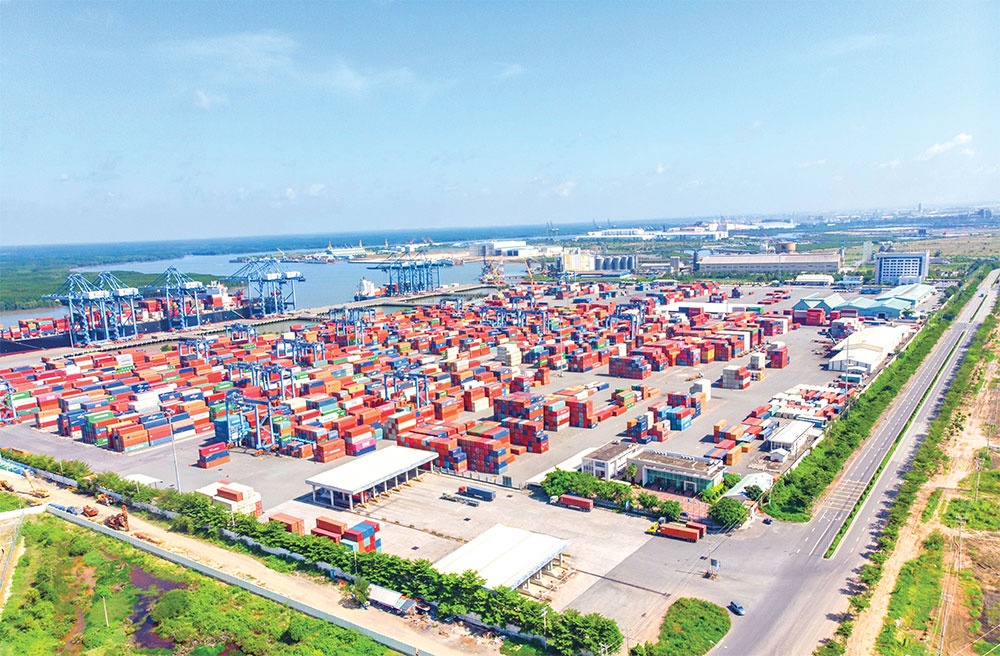Vietnamese ships to conquer the global supply chain seas
The results of the Vietnam Logistics Forum in the northern city of Haiphong at the end of last month did not meet expectations, following the absence of government members and key agencies who were supposed to take crucial steps to develop Vietnam’s fleet.
 |
| Vietnamese ships to conquer the global supply chain seas - illustration photo/ Le Toan |
Increasing the exports of goods and winning back part of the benefits from international shipping lines are some goals, but the industry, trade, and agriculture industries – all closely related to Vietnam’s import and export of goods – are far from sketching out a plan through seaports that is suitable as supply chain shifts become more profitable and the benefits are increasingly concentrated on the world’s shipping lines.
The project for developing Vietnam’s shipping fleet was presented by the Ministry of Transport (MoT) at the forum, and the initial reaction was disappointment. Even a representative of a logistics company said that this scenario would “create new employment plans for foreign businesses” rather than domestic ones.
Deputy Minister of Transport Nguyen Xuan Sang signed the project’s plan a month ago under Decision No.1254/QD-BGTVT, stating the goal of developing a dedicated container fleet. The project is hoped to increase Vietnam’s transport market share in Asia to 10 per cent by 2026 and 20 per cent by 2030, laying what it says is a solid foundation for the exploitation of long-distance transport routes.
The development of Vietnam’s shipping fleet would be carried out in two phases. From now to 2026, the focus would be on amending and supplementing regulations on purchase, sale, registration of ships; and price management of maritime services and container transport activities of foreign shipping lines in Vietnam. After 2026, the focus would shift to support Vietnamese container shipping lines to expand internationally to Japan, India, Europe, and the US, as well as introduce a mechanism to link container shipping lines to increase competitiveness, along with promoting and supporting the use of clean fuel.
The prospects of developing Vietnam’s own fleet stand good, as over 80 per cent of global trade volume is transported by sea, according to the World Trade Organization.
However, Vo Duy Thang, head of the MoT’s Transportation and Maritime Services, said, “The competitiveness is getting tougher as foreign shipping lines are allowed to partially participate in the local shipping market, as committed to in the EU–Vietnam Free Trade Agreement.”
Thang pointed out the fact that the international shipping market share of Vietnam’s fleet is on a downward trend. “In the 2016-2020 period, the number of ships ranged from 1,000 to over 1,200. But compared to 2016, the figure has decreased by over 200 ships in 2021, equivalent to a decrease of 17.2 per cent. Compared to the 2010-2015 period, Vietnam’s fleet has declined by over 400 ships, despite the total tonnage of the fleet growing by over 6 per cent. Now, Vietnam is lacking in container ships and large tonnage ships operating on international routes.”
As of December 2021, the fleet of ships under Vietnamese flag has counted just over 1,500 units, with a total capacity of about 7.1 billion GT and a total tonnage of about 11.7 million DWT. But among the 1,032 specialised vessels with a total tonnage of about 6.3 million GT and 10.6 million DWT are mainly small ships of less than 5,000GT, and some medium ships of less than 10,000GT.
“We have 11 container shipping lines with about 40 ships, with a total tonnage equivalent to about 48,000TEU, mainly operating in the domestic market,” Thang said. “The market share of goods to the international market belongs to 38 foreign shipping lines, including the largest shipping lines in the world.”
Vietnam has a strategic geographical position with a long coastline and proximity to important international shipping lanes. In 2020, Vietnam’s seaport system approved 692.2 million tonnes, and in 2021, throughput reached 706 million tonnes.
Vietnam’s goods exports by sea are increasing. According to the study on the development planning of the seaport system in the 2021-2030 period, it is forecasted that goods through local seaports will be about 1.1-1.4 billion tonnes by 2030.
Le Quang Trung, deputy general director of Vietnam Maritime Corporation, said investment processes and capital constraints are the biggest challenges in developing a Vietnamese fleet.
“Developing a fleet of Vietnamese-branded ships is essential to avoid letting profits fall into the pockets of foreign shipping lines. We need a more specific investment roadmap that includes finalising procurement and bidding policies, to avoid introducing ways to charter ships among foreign traders,” Trung said.
| The importance of integrating policy to shore up supply chains |
What the stars mean:
★ Poor ★ ★ Promising ★★★ Good ★★★★ Very good ★★★★★ Exceptional
Related Contents
Latest News
More News
- Financial sector charts next steps as Party Congress convenes (January 21, 2026 | 09:58)
- Three key dynamics supporting Vietnam’s GDP growth in 2026 (January 20, 2026 | 16:34)
- Carlsberg Vietnam and Grab encourage responsible enjoyment and safer mobility (January 16, 2026 | 19:55)
- Redefining Vietnam’s growth model for the era of innovation (January 16, 2026 | 16:40)
- Nghi Son refinery processes first non-Kuwaiti crude cargo (January 16, 2026 | 16:06)
- Siemens and VSIP announce landmark strategic partnership (January 15, 2026 | 14:48)
- VinFast sets record with 175,099 electric vehicles delivered in Vietnam in 2025 (January 15, 2026 | 14:24)
- Year-end shopping season faces rising uncertainty (January 14, 2026 | 18:11)
- State sector sees broad-based profit surge as major groups deliver strong results (January 13, 2026 | 17:34)
- HSBC forecasts Vietnam's GDP growth to hit 6.7 per cent in 2026 (January 13, 2026 | 17:33)

 Tag:
Tag:





















 Mobile Version
Mobile Version